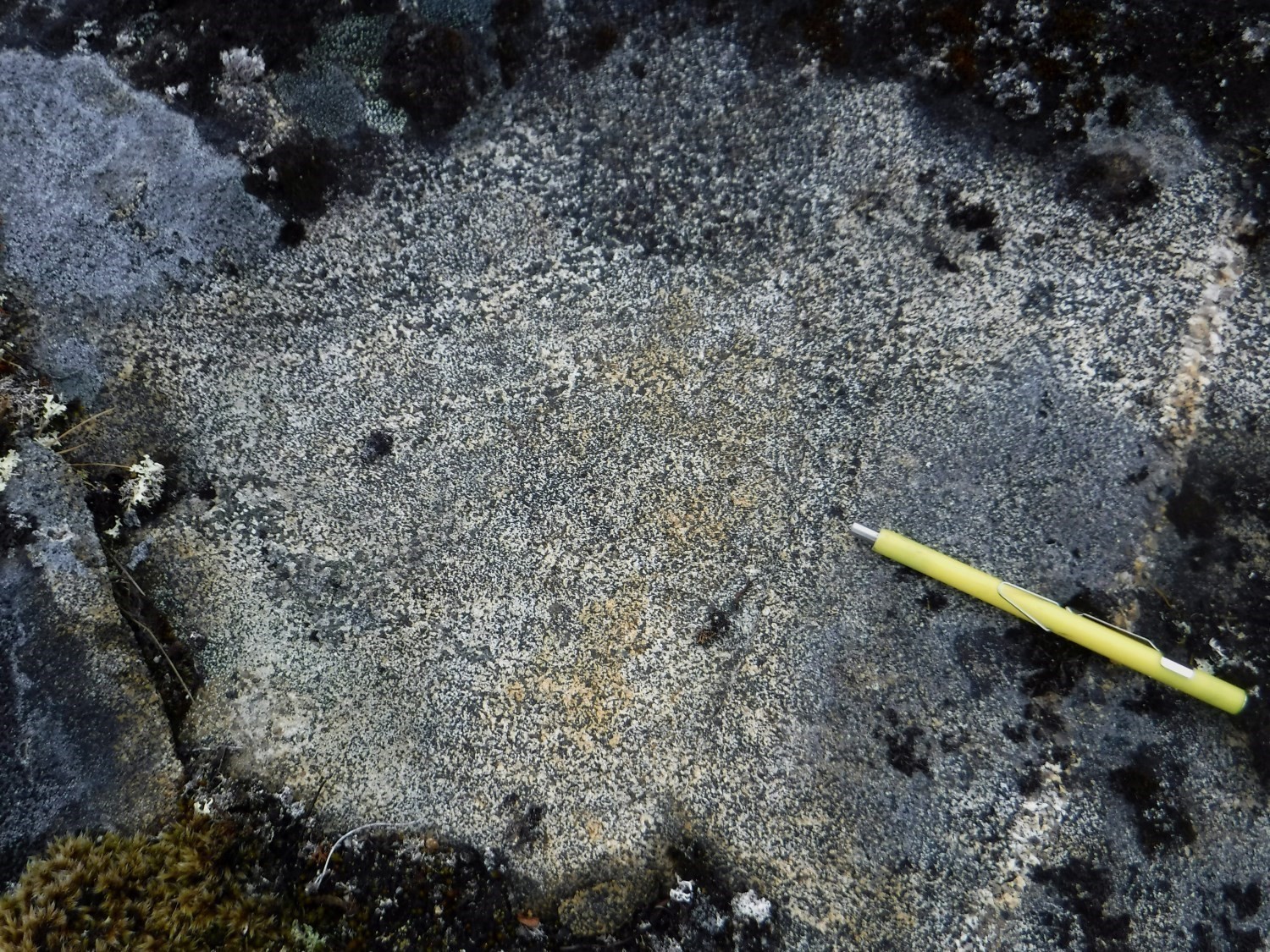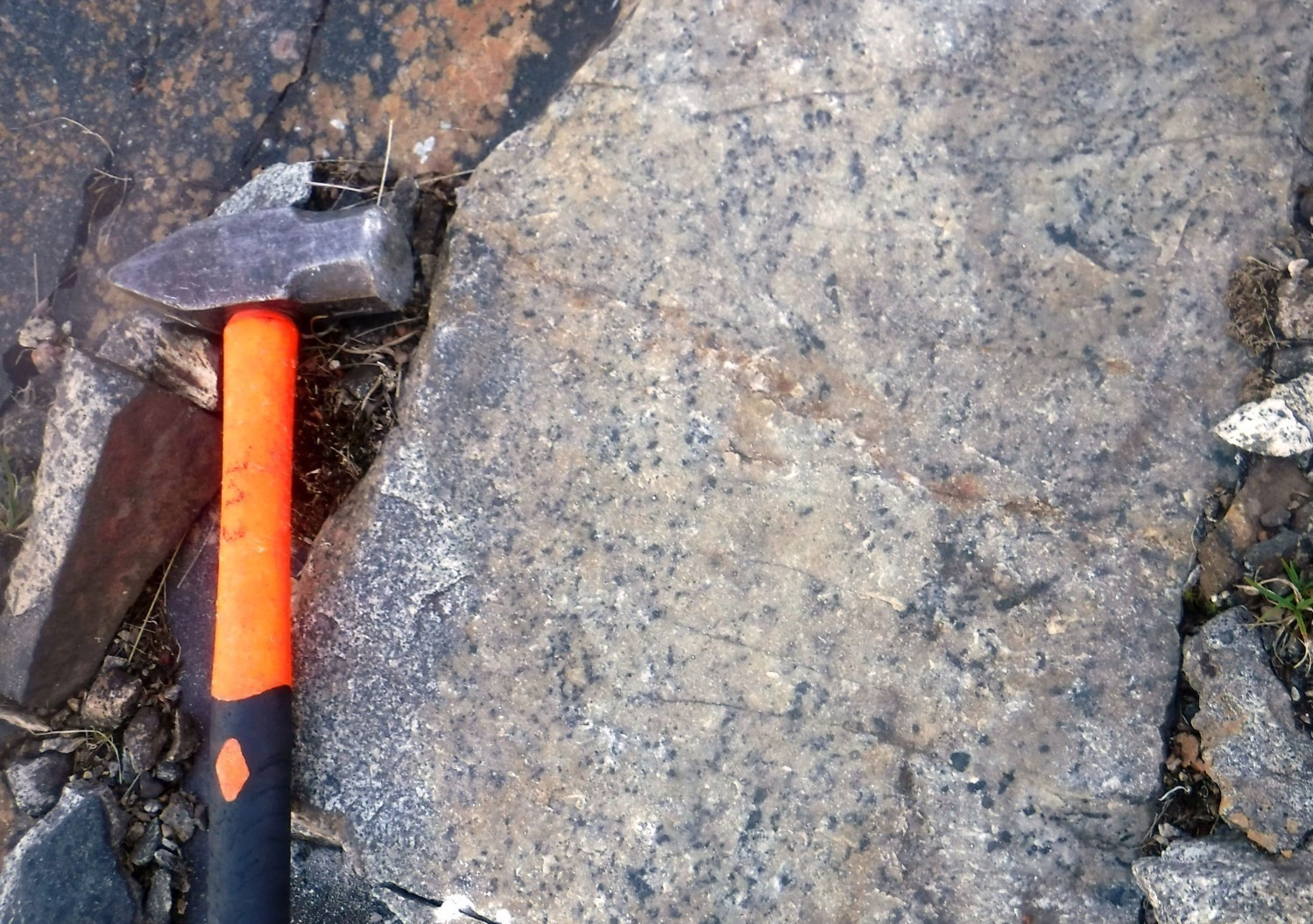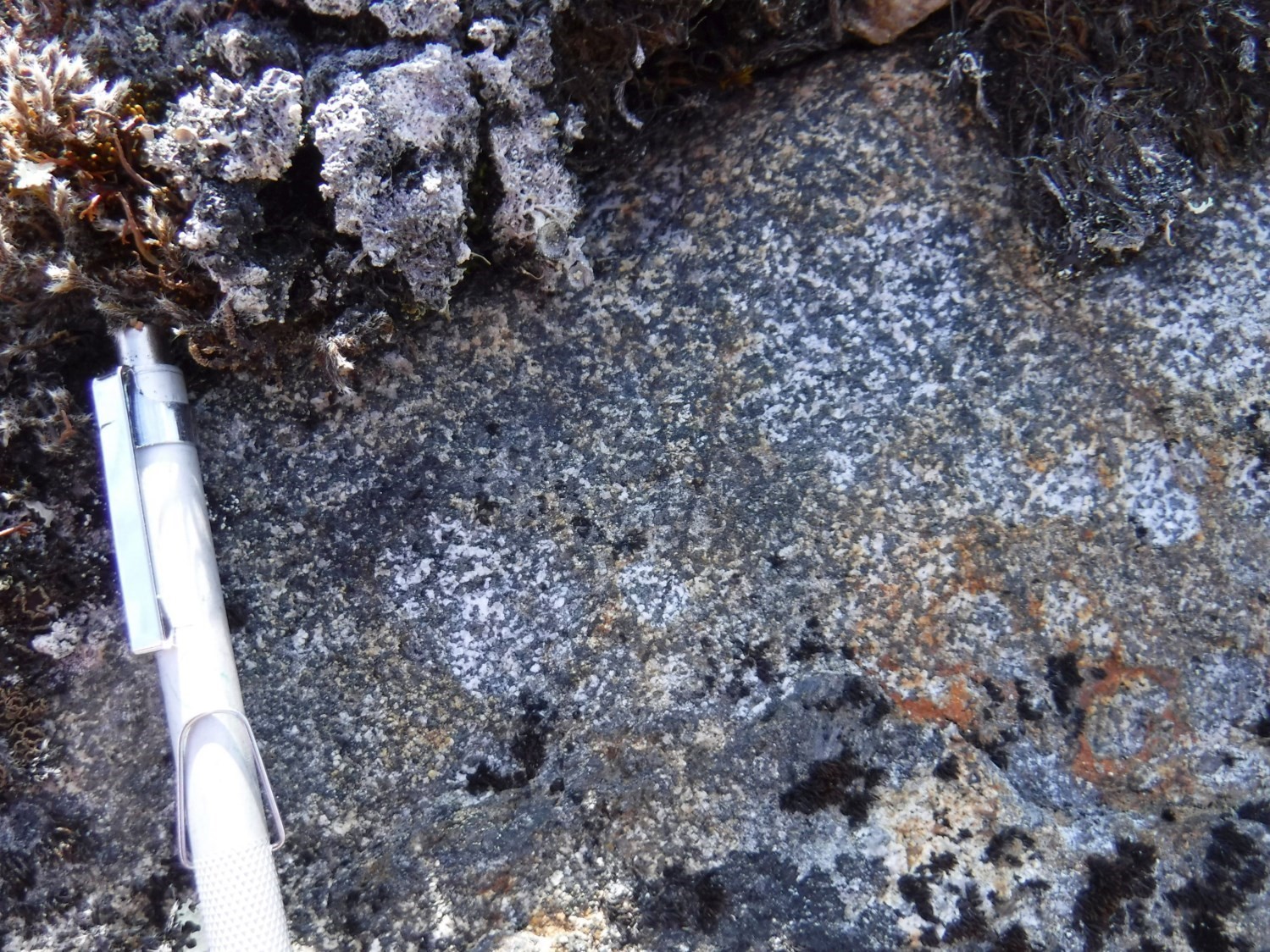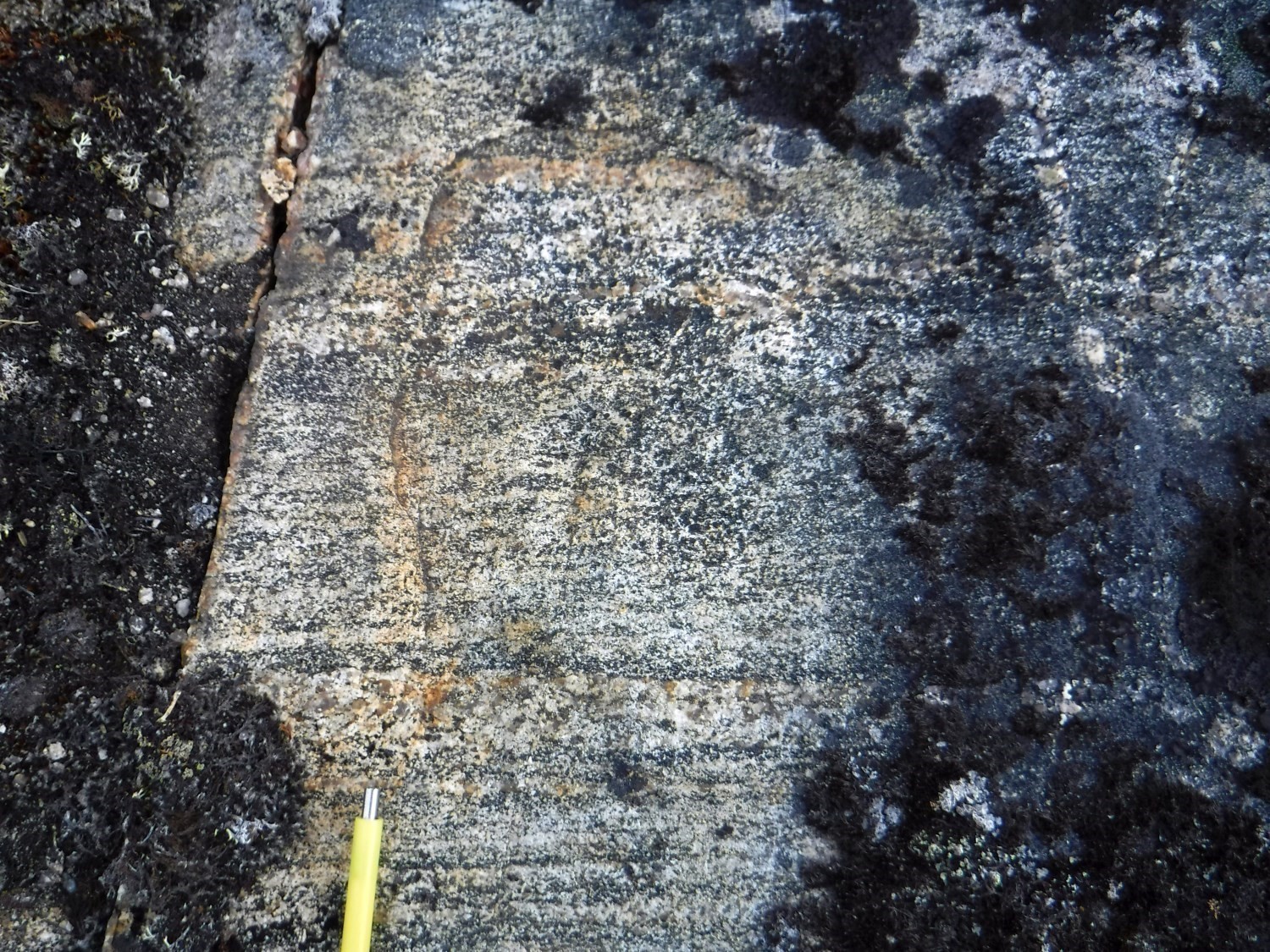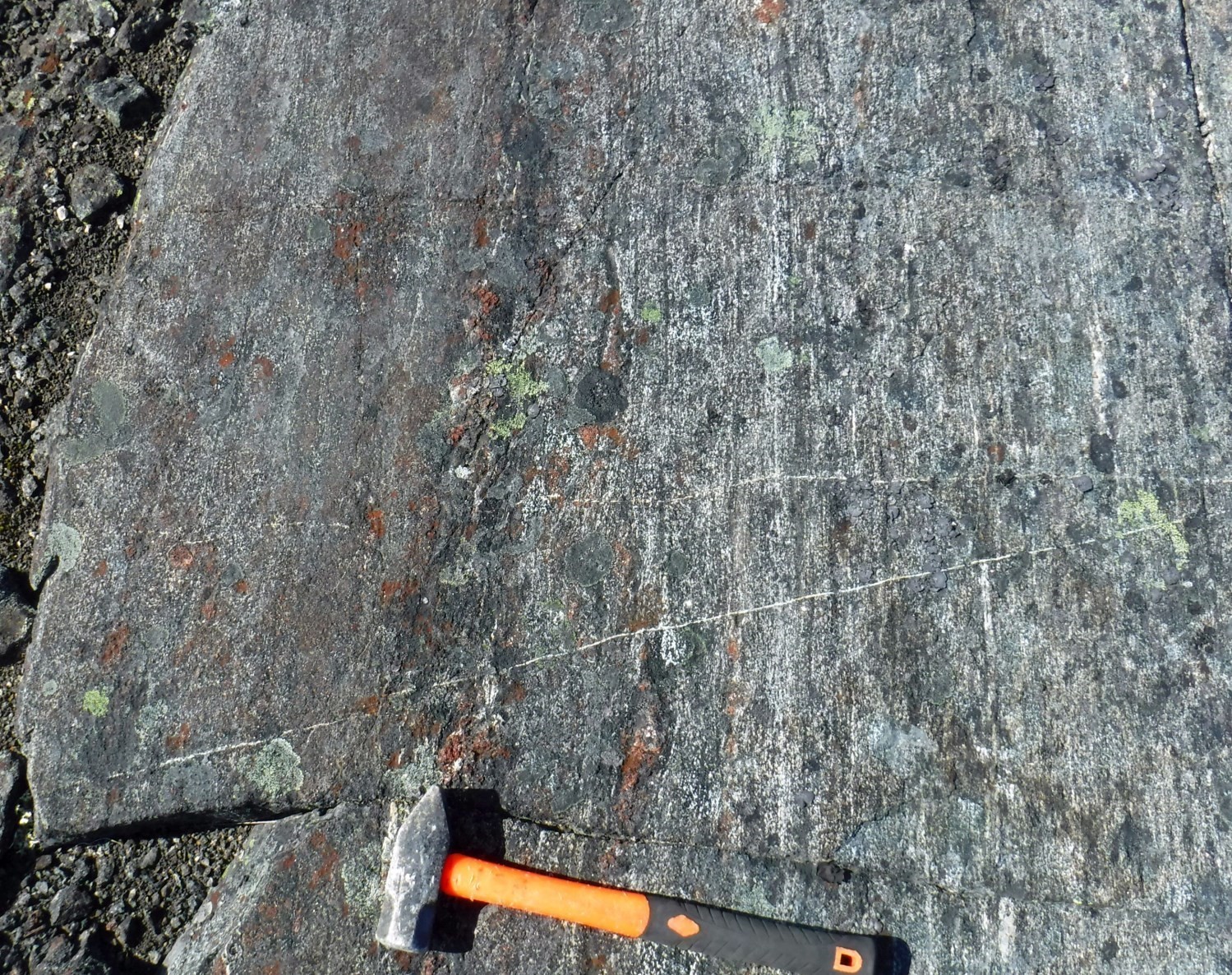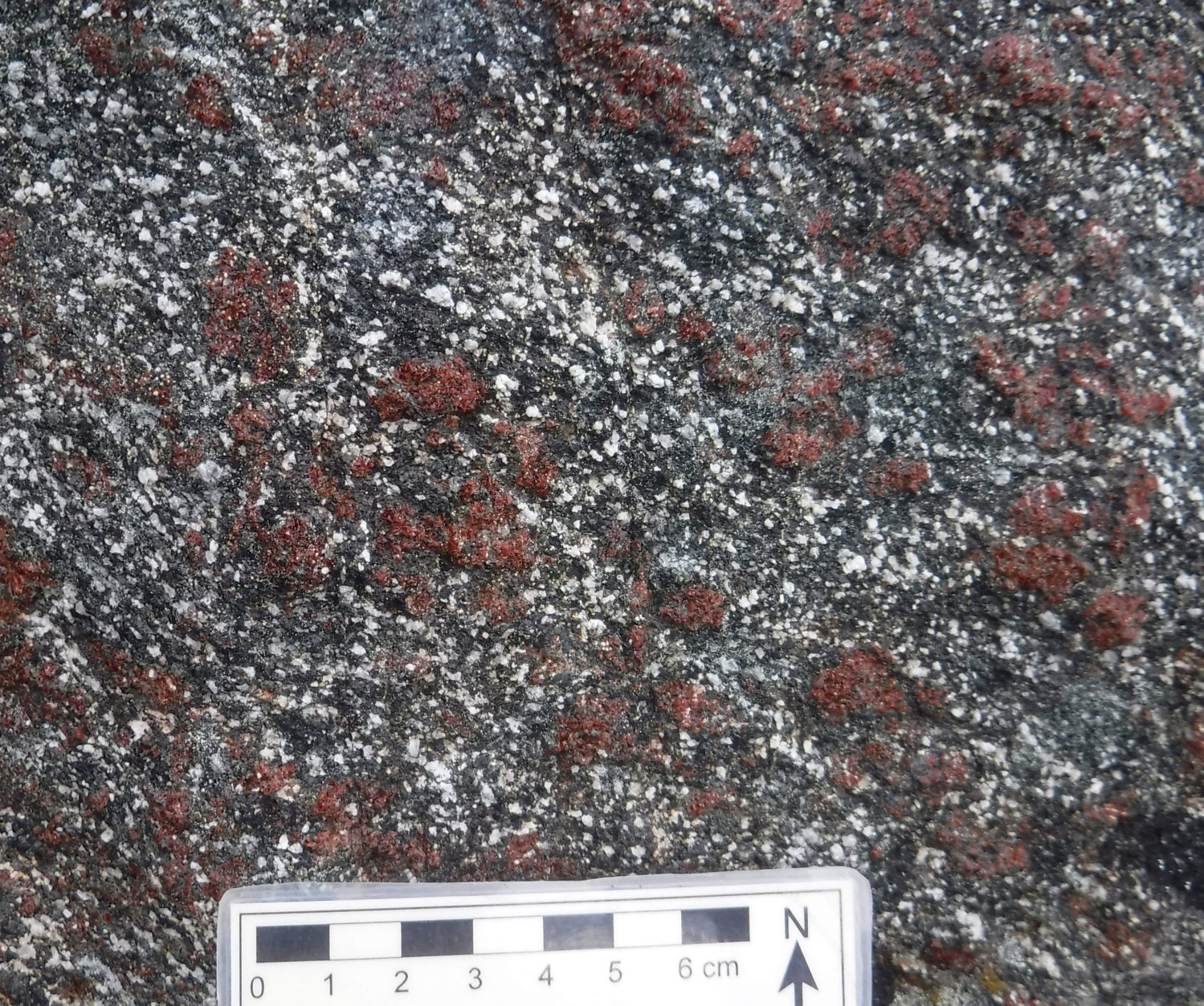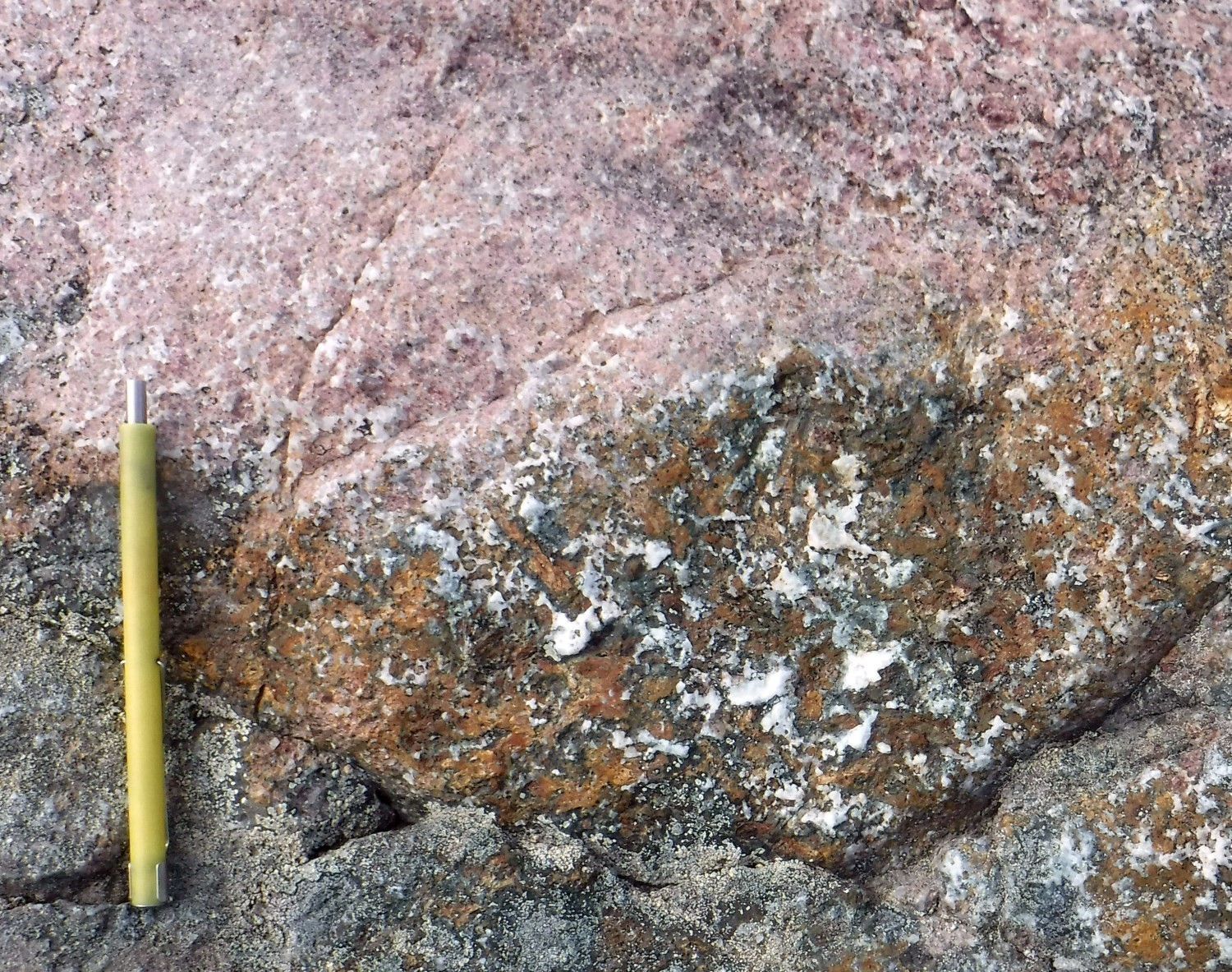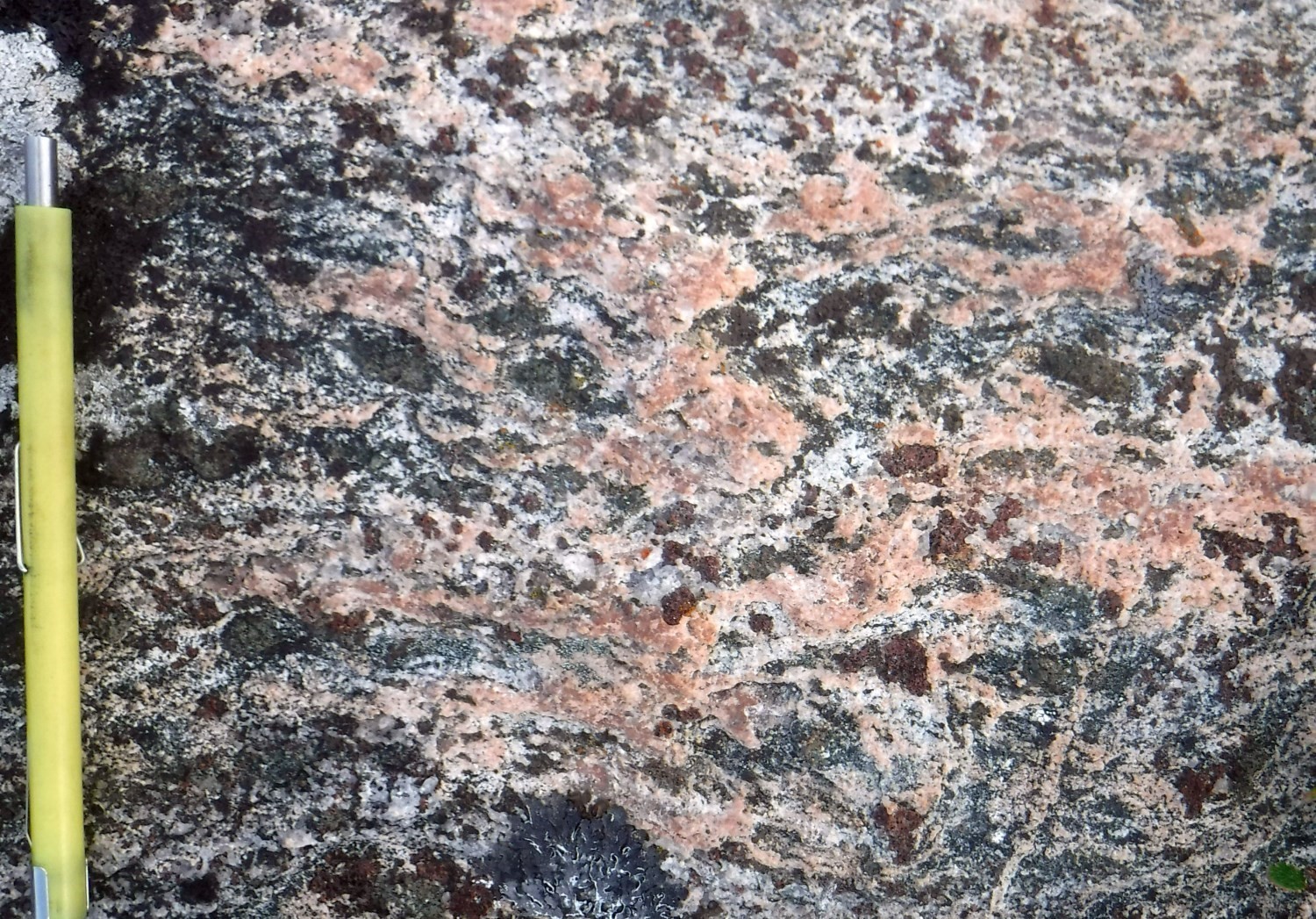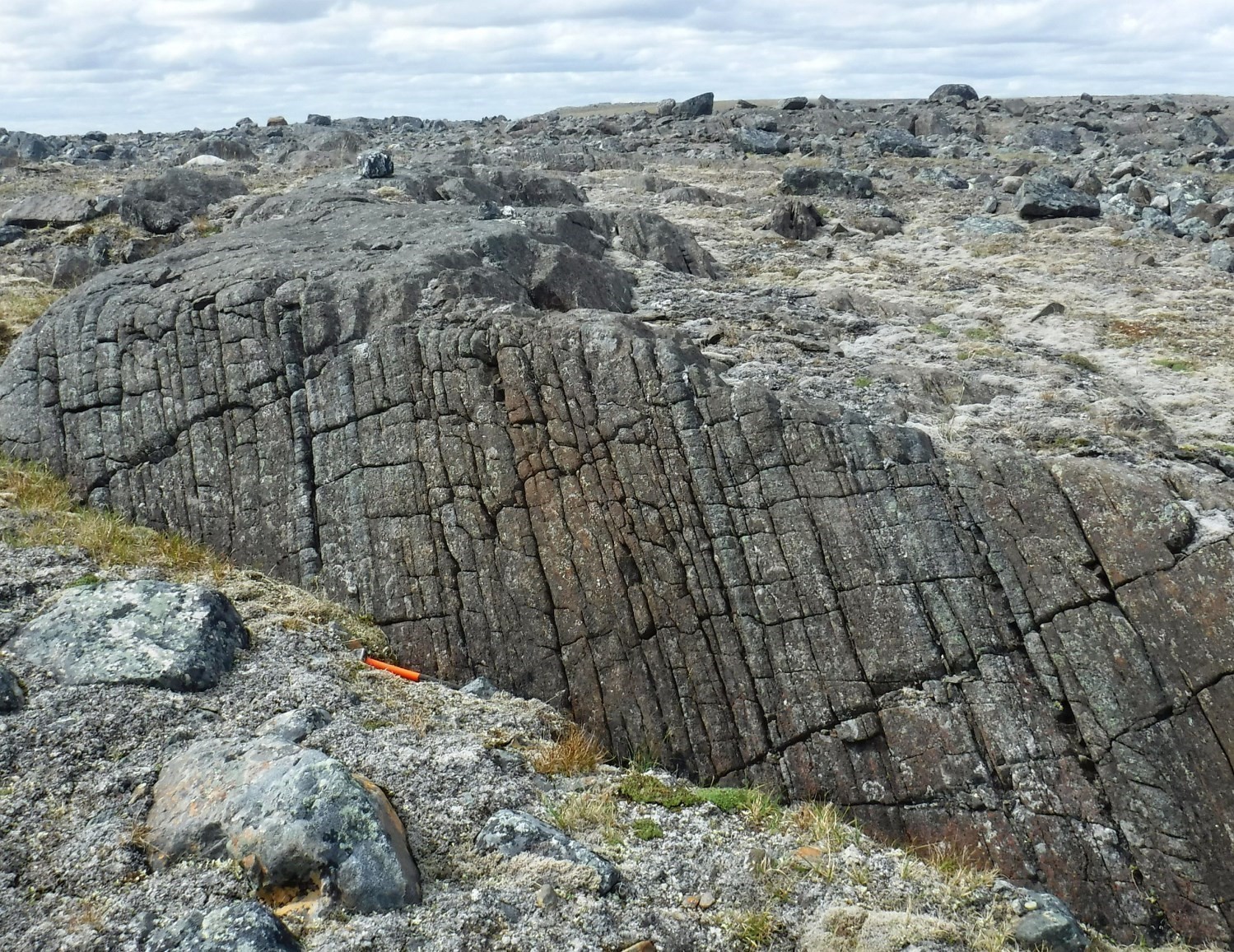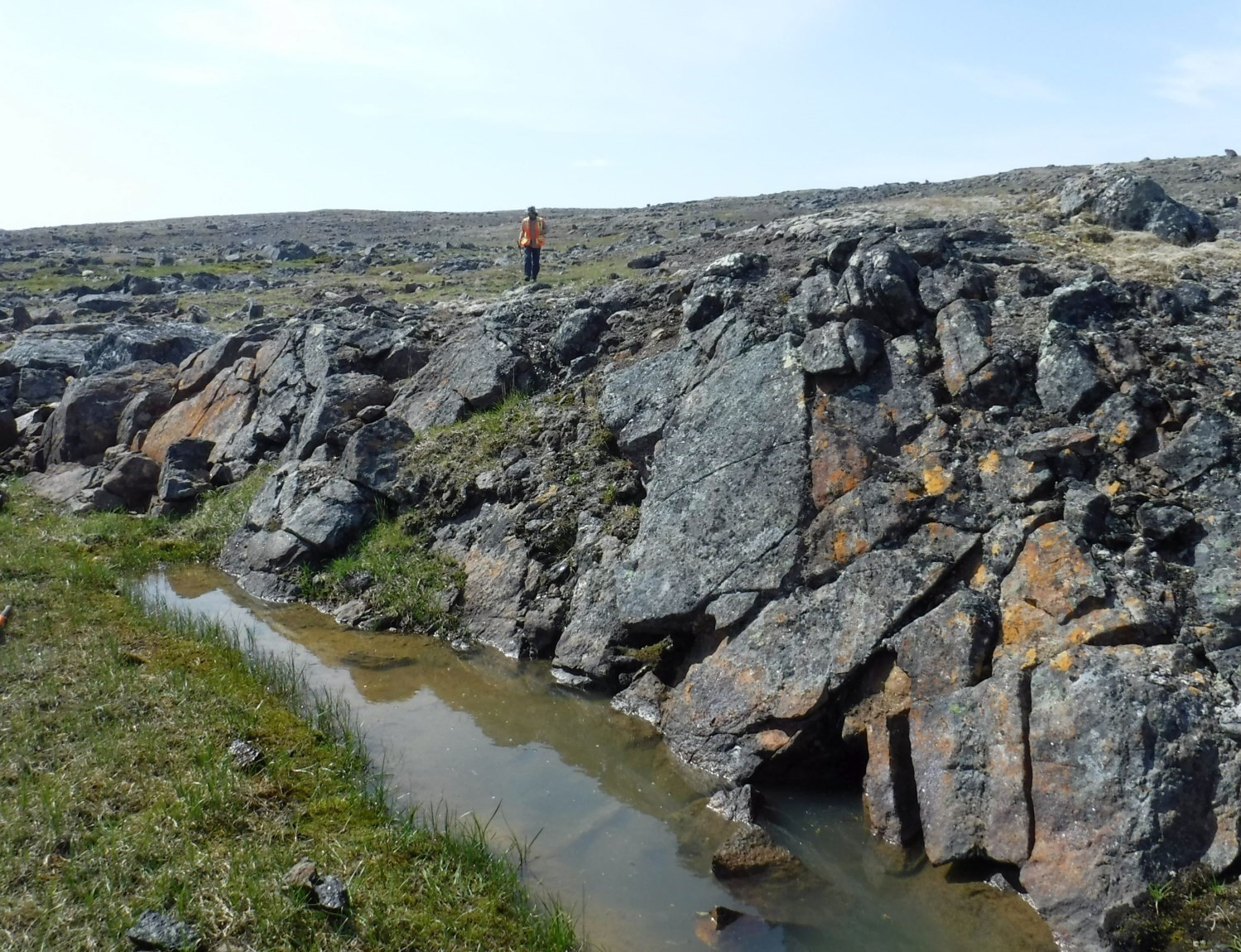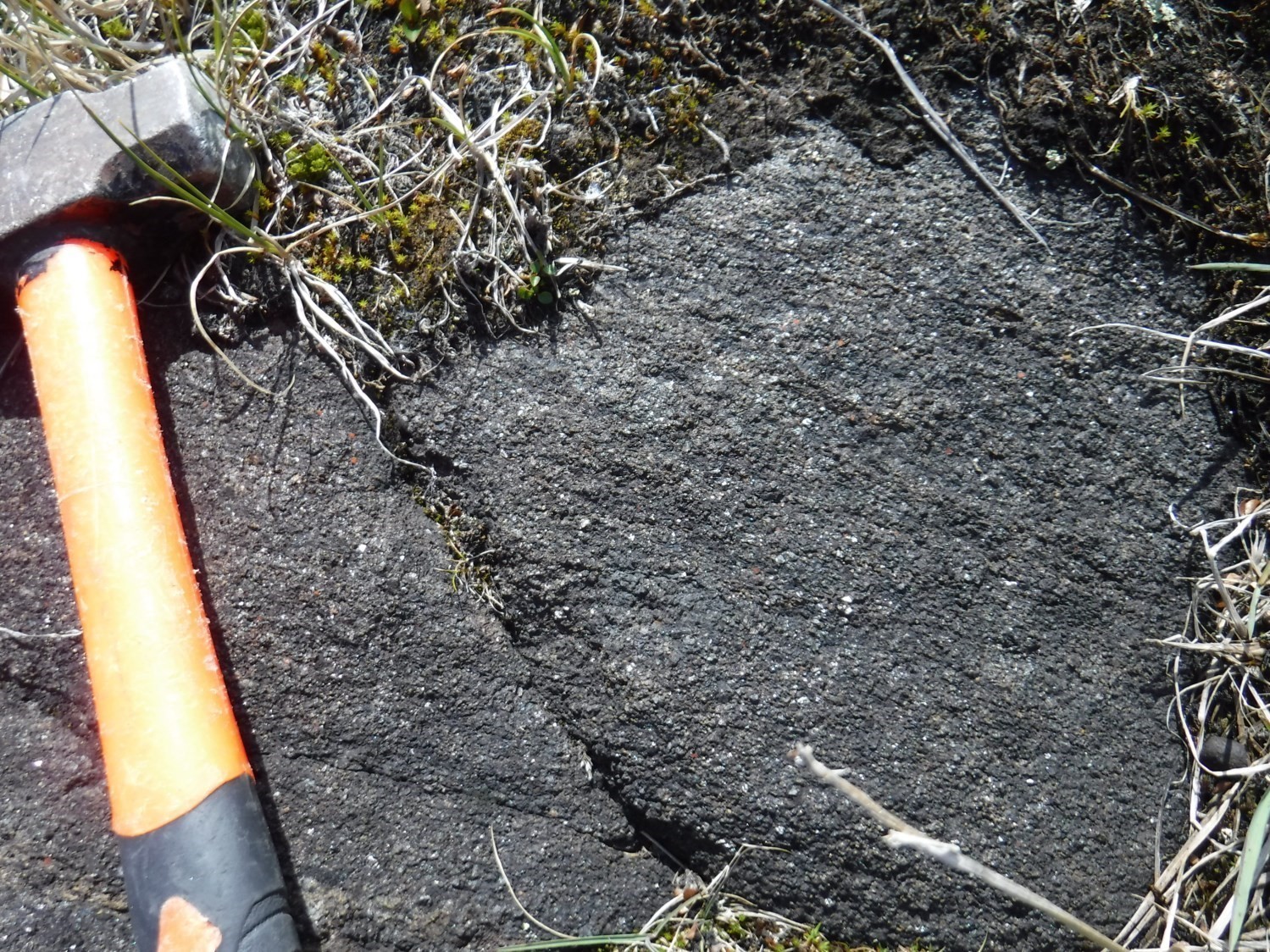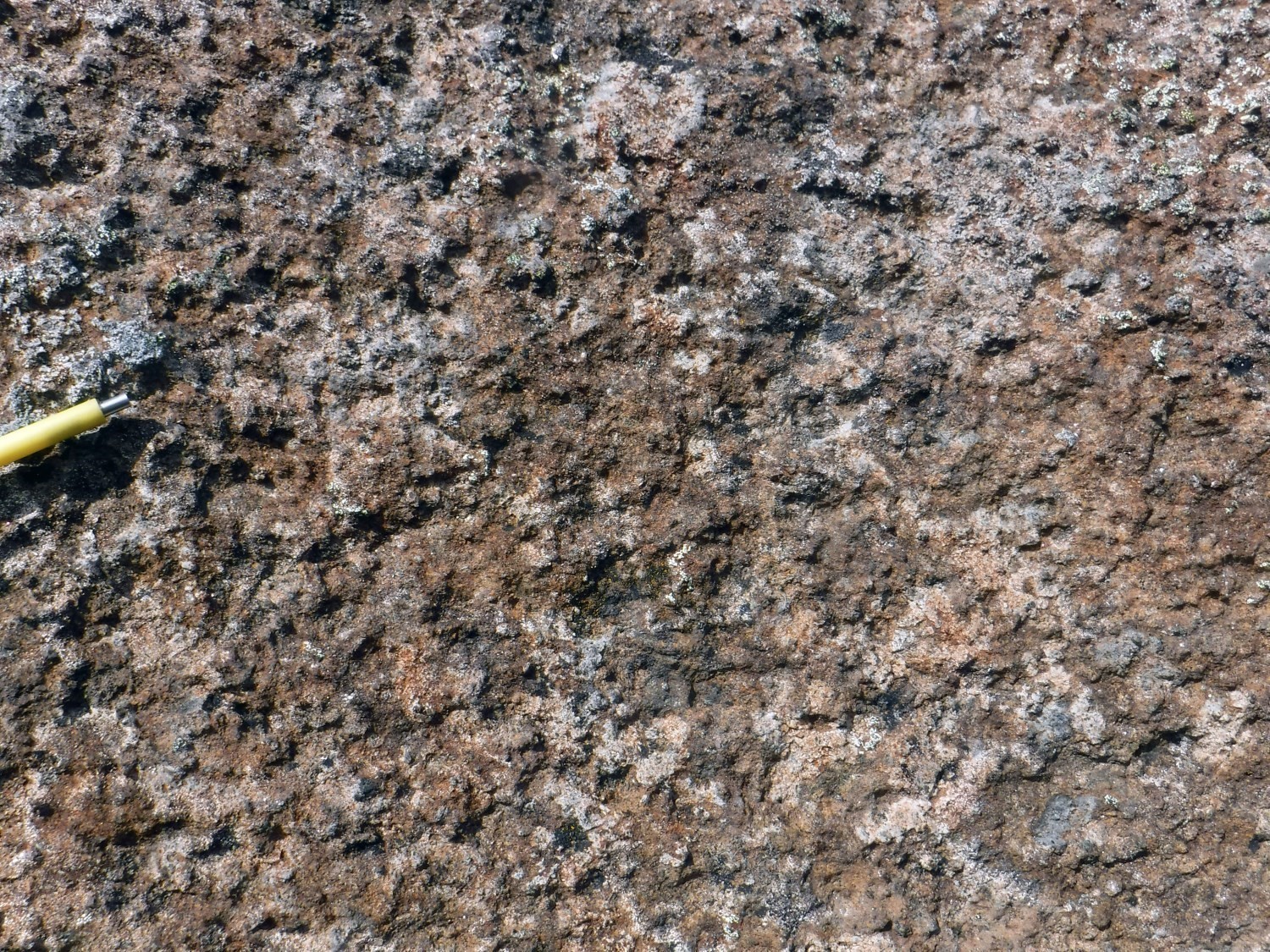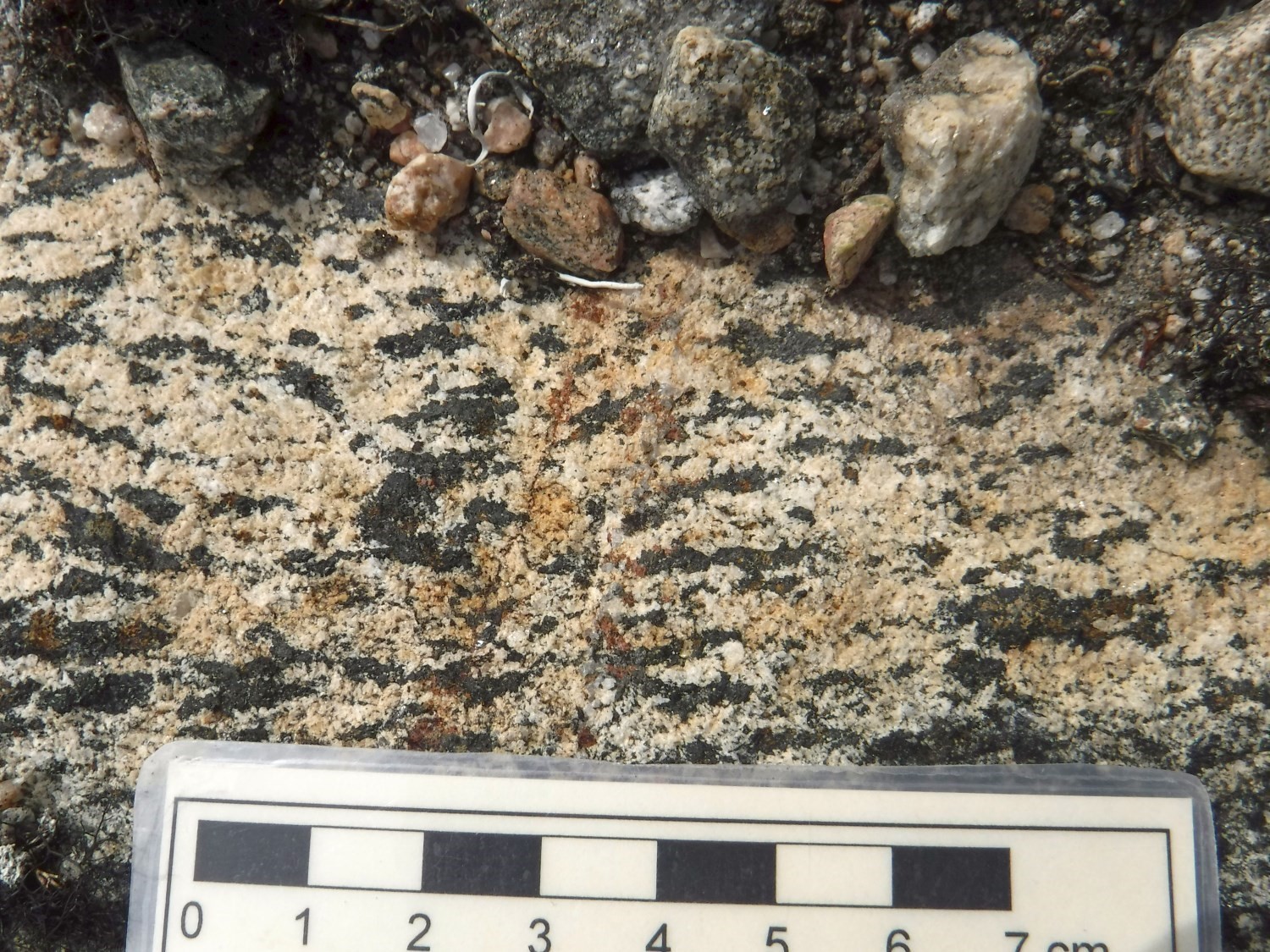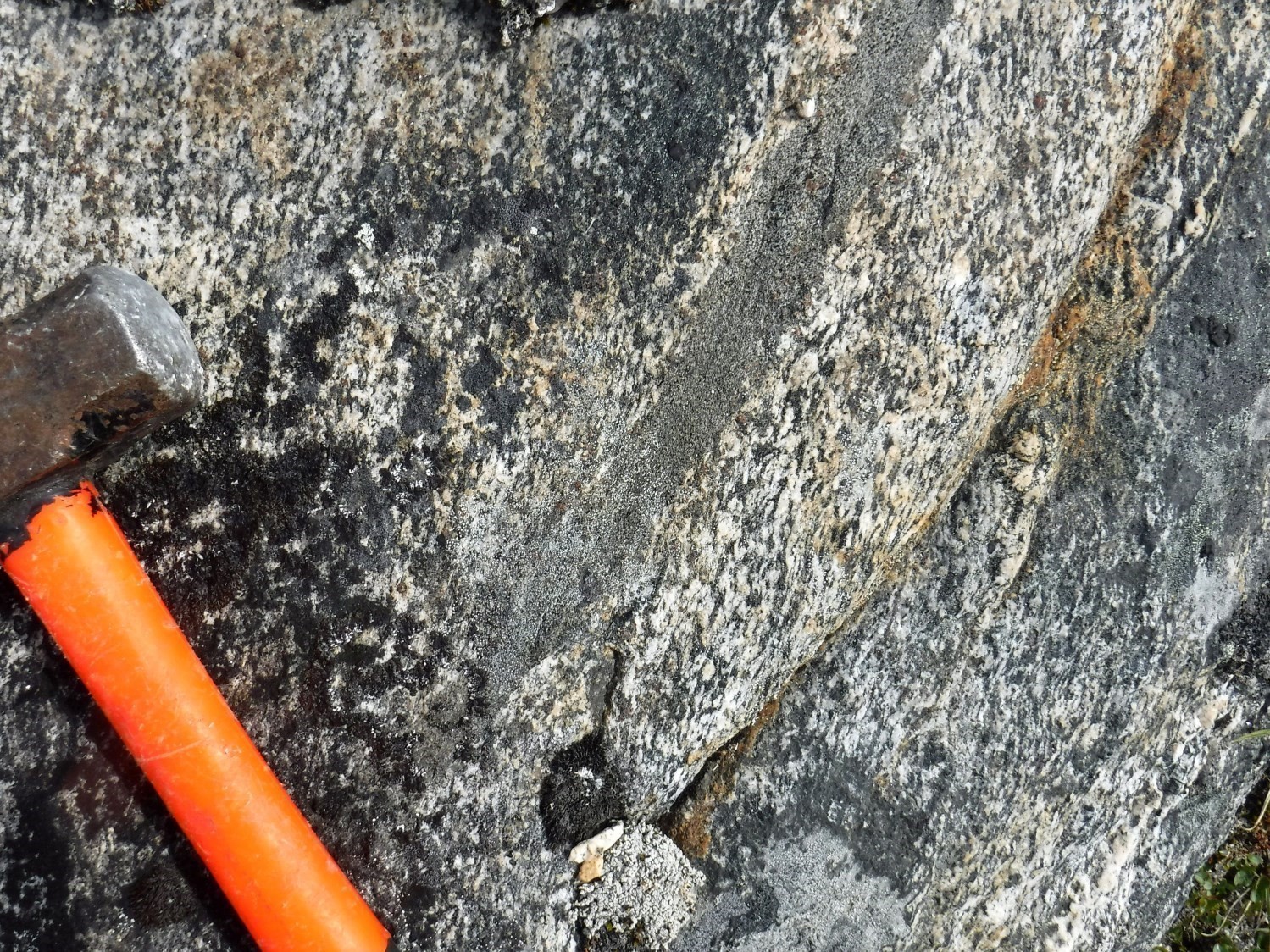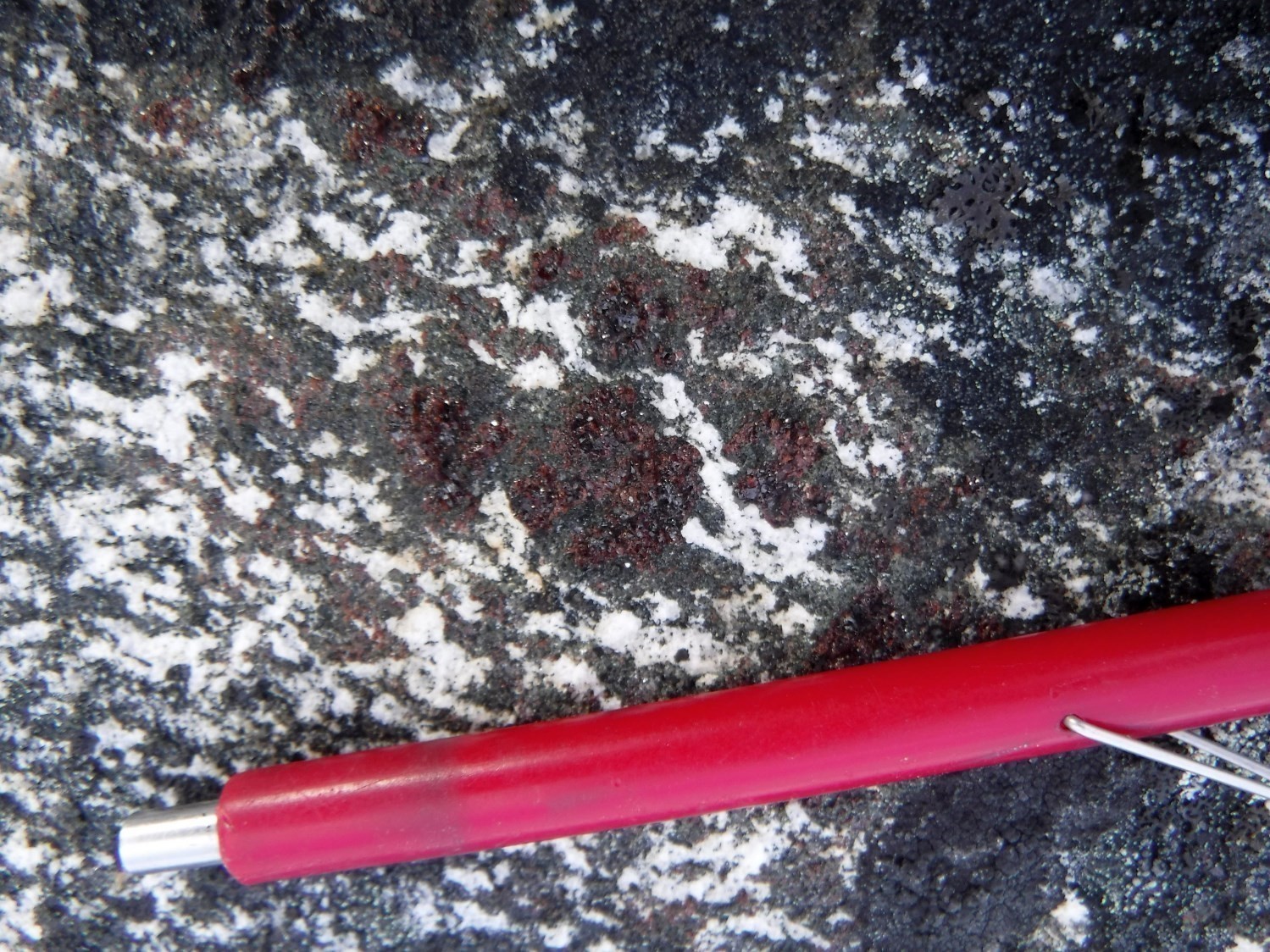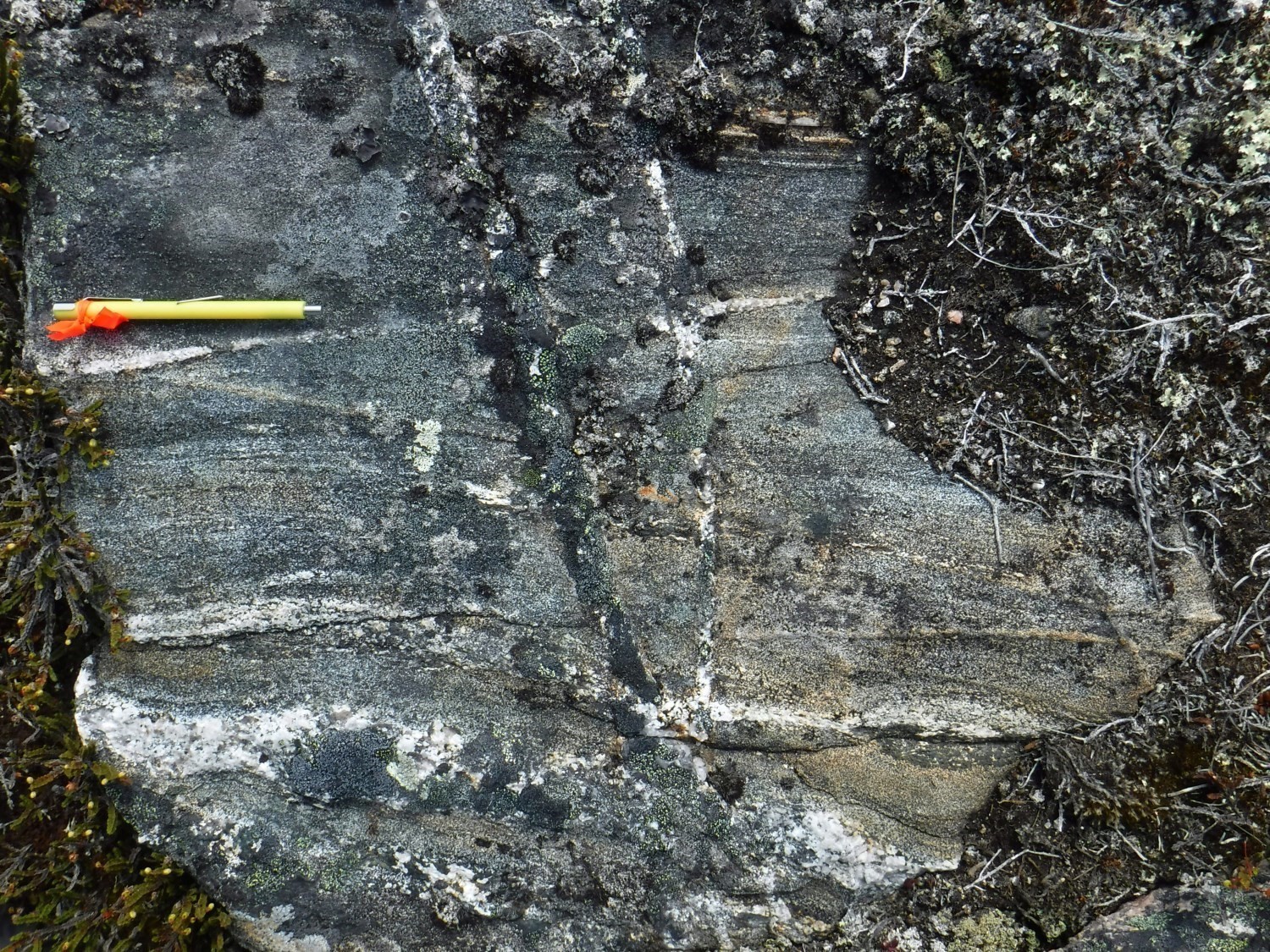
| Author: | Charette and Beaudette, 2018 |
| Age: | Neoarchean |
| Stratotype: | None |
| Type area: | NW part of the Ungava Peninsula |
| Geological province: | Churchill Province |
| Geological subdivision: | Ungava Orogen / Narsajuaq Lithotectonic Domain |
| Lithology: | Intermediate to mafic granulitic rocks |
| Category: | Lithodemic |
| Rank: | Complex |
| Status: | Formal |
| Use: | Active |
None
Background
The Pingasualuit Complex was introduced ine the Cape Wolstneholme area by Charette and Beaudette (2018) to group mafic to intermediate granulitic intrusions of the Narsajuaq Domain. It was extended in the Sirmiq Lake area (Vanier and Lafrance, 2020), where three new units were identified. Units of this complex were previously part of the older (pPNAR1) and younger (pPNAR2) plutonic suites, described by St-Onge and Lucas (1992) and St-Onge et al. (1992).
Description
The Pingasualuit Complex is divided into five informal units: 1) gabbronorite and hypersthene diorite; 2) variably-migmatized hypersthene quartz diorite and hypersthene diorite ; 3) migmatized garnet gabbro and gabbronorite; 4) foliated ultramafic rocks; and 5) speckled gabbro and gabbronorite. This complex is characterized by a granulite facies paragenesis. In places, mafic to ultramafic klippes at the amphibolite facies, possibly retromorphosed, are included in units nApgs1a, nApgs4 and nApgs5.
Pingasualuit Complex 1 (nApgs1): Mesocratic Gabbronorite and Hypersthene Diorite
Unit nApgs1 consists of gabbronorite and hyperstene diorite, more locally of jutonite, dark greenish grey to dark brownish. The rock is even grained and at the limit between fine and medium grained. The rock is commonly homogeneous and foliated, but also banded. Banding is produced by varying modal contents of ferromagnesian minerals (40-70%)or by the prsence of diffuse leucosomes (<10%), which forms millimetric to centimetric clusters or bands. They are slightly coarser grained than the matrix. They are partially recrystallized, oriented along foliation and contain clinopyroxene, orthopyroxene and hornblende isolated crystals or clusters. Locally, garnet clusters or millimetric crystals are observed. In the Cape Wolstenholme area, Charette and Beaudette (2018) also assigned speckled rocks to unit nApgs1. This appearance is due to millimetric to centimetric clusters of ferromagnesian minerals and recrystallized plagioclase clustersf <1 cm. Rocks displaying this texture in the Sirmiq Lake area were instead assigned to unit nApgs5 (Vanier and Lafrance, 2020).
In thin sections, the rock texture is polygonal to interlobed. Hornblende and clinopyroxene are the main ferromagnesian minerals, followed by orthopyroxene and biotite. Clinopyroxene is commonly amphibolitized and orthopyroxene is partially replaced by serpentine and oxides. Hornblende is slightly coarser than other minerals and marks foliation. It occurs as poikiloblastic crystals in some samples. Accessory minerals are sparse, the main ones being opaque minerals, apatite, garnet, quartz and carbonates.
Pingasualuit Complex 1a (nApgs1a): Gabbro, Diorite and Ultramafic Rocks
Unlike rocks of unit nApgs1, rocks of subunit nApgs1a are brownish in fresh exposure, typical of orthopyroxene rocks, and their alteration patina ranges from greenish black to dark green. Except for their colour, the appearance of these rocks in outcrop differs little from the rest of unit nApgs1. In thin sections, the presence of serpentine clusters and orthopyroxene cores locally preserved in hornblende crystals suggests that they are granulitic rocks retromorphosed to the amphibolite facies. In addition to those listed for unit nApgs1, accessory minerals include epidote, allanite and chlorite, and are present everywhere in low amounts.
In the Cape Wolstenholme area, Charette and Beaudette (2018) also assigned ultramafic rocks and a speckled phase to this subunit. Being more abundant in the Sirmiq Lake area, these phases were rather assigned to units nApgs4 and nApgs5 respectively by Vanier and Lafrance (2020). The speckled phase contains clusters of ferromagnesian minerals and small centimetric plagioclase crystals. In places, ferromagnesian mineral clusters are centimetric and joint, giving a recrystallized cumulate appearance. Ultramafic rocks form layers and boudins in gabbro and diorite of subunit nApgs1a. They locally contain fractured olivine crystals (<10%) partially replaced by iddingsite and magnetite. Moreover in the Cape Wolstenholme area, no orthopyroxene was observed in the area north of the Naujaat Shear Zone. Lithologies in this area are foliated and homogeneous; in places, they display discontinuous leucosomes indicating partial melting. Microscopic observations identify hornblende, actinolite and clinopyroxene as the main ferromagnesian minerals. Clinopyroxene is variably amphibolitized and biotite replaces hornblende in fracture and cleavage planes.
In the Sirmiq Lake area (Vanier and Lafrance, 2020), subunit nApgs1a also includes sparse metric to decametric anorthosite layers. More sparsely, anorthosite was also observed in nApgs3 unit. The latter contains 8-10% ferromagnesian minerals dominated by hornblende or very highly uralitized clinopyroxene, with low contents of biotite and magnetite. Secondary minerals are chlorite, apatite, epidote, carbonate and quartz.
Pingasualuit Complex 1b (nApgs1b): Magnetite-Ilmenite Gabbronorite
Decimetric to hectometric layers of iron oxides-rich gabbronorite are locally present in unit nApgs1 gabbronorite, Estre Complex granulitic gneiss or Navvaataaq Suite enderbite. At first glance, these layers resemble unit nApgs1 gabbronorite, but contain 10-15% opaque minerals (magnetite, ilmenite). Ferromagnesian minerals (40-50%) are dominated by clinopyroxene, and orthopyroxene (5-10%) is ubiquitous. These pyroxenes are only slightly replaced by hornblende. Subunit nApgs1b locally contains centimetric to decimetric bands rich in garnet (5-15%) and containing up to 1% apatite.
Pingasualuit Complex 2 (nApgs2): Hypersthene Quartz Diorite and Hypersthene Diorite
Hypersthene quartz diorite and hypersthene diorite are the main phases of unit nApgs2. However, it also includes local jotunite and enderbite. In places, these variations are observed in diffuse centimetric bands within the same sample. Rocks of unit nApgs2 are medium grained, even grained, foliated and greenish grey to brown sugar. They commonly exhibiting banding marked by the presence of ferromagnesian mineral laminae and millimetric to centimetric leucocratic bands (5-20%). These are brownish to whitish beige in altered surface, and their composition generally varies from quartz dioritic to tonalitic, (and locally granitic). Some of these bands are medium grained, conformable to foliation and in diffuse contact in the matrix. They occur as lenticular clusters in places and commonly include orthopyroxene, clinopyroxene and magnetite crystals. These bands are interpreted as leucosome derived from melting of intermediate granulitic rocks of the Pingasualuit Complex,. Other bands are slightly coarser grained than the fine-grained matrix, are subconformable to or cutting foliation, and are in sharp contact. In places, these coarser-grained bands include quartz bands. At the outcrop scale, banding is also marked by compositional variations produced by variation in ferromagnesian mineral contents (10-40%) within quartz diorite or hypersthene diorite. Centimetre to metre-thick layers of unit nApgs1 gabbronorite are present in sharp or diffuse contact within granulitic intermediate rocks. These layers are usually more competent and less banded than host rocks.
In diffuse contact with the banded phase, a second phase of unit nApgs2 is homogeneous, sligtly coaser-grained and speckled. This phase is characterized by millimetric clusters of ferromagnesian minerals and slightly coarser plagioclase crystals producing the speckled appearance. The modal proportion of ferromagnesian minerals (10-20%) is generally lower than in the main phase.
In thin sections, grains exhibit an interlobed to partially granoblastic fabric. Plagioclase locally forms rounded millimetric crystals (3-7 mm) coarser than the matrix, while ferromagnesian minerals are in discontinuous millimetric laminae, in clusters aligned in foliation, and disseminated in the matrix. If present, K-feldspar is distributed heterogeneously as fine crystals disseminated in the matrix, as inclusions in plagioclase or as fine laminae. Hornblende and pyroxene are the main ferromagnesian minerals, followed by biotite. The modal proportion of these minerals varies by band. In some cases where pyroxene is not uralitized, hornblende can be absent. The latter either occurs as recrystallized even-grained crystals or as crystals with a poikilitic core and a rim without inclusions. Pyroxene crystals are commonly elongated in the primary foliation. Specifically, orthopyroxene is fractured and partially replaced by serpentine and oxides. Biotite forms rosettes including quartz intergrowth and is observed partially replacing orthopyroxene or hornblende. Locally, garnet is present in small stocky crystals in equilibrium contact with hornblende. Epidote locally forms small stocky crystals associated with ferromagnesian laminae or clusters. In places, chlorite is replacing hornblende, biotite and garnet in fractures.
Pingasualuit Complex 3 (nApgs3): Migmatized Garnet Gabbro and Gabbronorite
Unit nApgs3 differs from other units of the Pingasualuit Complex by the greater presence of garnet, significant compositional variations and higher migmatization. Outcrops commonly exhibit alternating decametric to centimetric melanocratic, mesocratic and leucocratic gabbro (or gabbronorite), as well as local ultramafic rock layers. The garnet content also varies widely with composition, with some layers not even containing garnet. This banding is now transposed into foliation. It possibly reflects original variations of the unit, indicating contemporaneous intrusion of different magmas. Indeed, zones of magma mixing have been observed locally.
Gabbro and gabbronorite are also migmatized to varying degrees. The leucosome most commonly forms coarser and discontinuous clusters and bands millimetre to centimetre wide. They contain garnet, clinopyroxene or hornblende porphyroblasts. Stromatic areas were also observed locally. Garnet may be present in all phases of unit nApgs3, but the highest contents are associated with the leucosome, where it forms porphyroblasts up to 4 cm in diameter. They are commonly rimmed by clinopyroxene ± hornblende.
In thin sections, the general fabric is mostly even grained and granoblastic to interlobed (partial recrystallization), although coarser clinopyroxene and plagioclase crystals are still present. Plagioclase usually forms monomineralic clusters, locally lenticular, between ferromagnesian mineral clusters. These systematically include clinopyroxene, hornblende and fine magnetite grains. One sample contains orthopyroxene in smaller amounts. The latter can form large crystals or occur as highly serpentinized relics. Hornblende replaces clinopyroxene; it commonly forms a thin rim around it. In some layers, uralitization is more extensive and hornblende is the main ferromagnesian mineral.
Garnet occurs as millimetric grains and fractured subhedral poikiloblasts containing some plagioclase, clinopyroxene and orthopyroxene inclusions. Garnet is locally rimmed by hornblende-plagioclase symplectites. Locally, such symplectites are also observed without any residual garnet, or a very fine core. Except for magnetite (1-3%), accessory minerals are not abundant and include apatite, biotite and quartz.
Pingasualuit Complex 3a (nApgs3a): Garnetite and Metasomatic rocks
Subunit 3a comprises two main phases of metasomatized rocks within the Pingasualuit Complex. The first alteration phase consists of garnetite containing quartz (20-35%), clinopyroxene (<20%) and plagioclase (5-15%) in transitional contact with a garnet gabbro from unit nApgs3. On the same outcrop, garnet (20-60%) may be purplish pink or brown; these two types of crystals are in sharp contact. It occurs as fine grains aligned in banding or locally fractured porphyroblasts. Quartz occurs commonly coarse bands having subgrain extinction. Biotite (<8%) is chloritized to varying degrees. Garnetite layers also contain chalcopyrite (<1%) disseminated and filling fractures, as well as malachite and azurite coatings, and carbonate veinlets.
The second alteration phase is also composed of garnet, clinopyroxene, quartz and plagioclase in varying amounts. It also includes K-feldspar (10-40%) and magnetite (1-5%). K-feldspar and quartz locally form interconnected centimetric bands parallel to foliation. Garnet is porphyroblastic.
Pingasualuit Complex 4 (nApgs4): Foliated Ultramafic Rocks
Ultramafic rocks are generally foliated, black or dark grey in fresh exposure and brown or buff in patina. They form klippes decimetre to >350 m thick within various units of the Narsajuaq Domain. Locally, decimetric to metric rusyt layers, containing disseminated or nodular sulphides (<12% pyrrhotite ± chalcopyrite ± pentlandite) and malachite were observed. Unit nApgs4 consists of three distinct phases: olivine websterite, websterite, and more locally, lherzolite. For these three phases, the rock can contain up to 5% plagioclase in interstitial clusters and be cut by carbonate-serpentine veinslet. If present, olivine is fractured, variably serpentinized (antigorite or iddingsite) and appears to be more highly affected by deformation than other mineral phases. Locally, olivine can also be replaced by a carbonate-talc-tremolite assemblage.
Olive websterite is composed of pyroxene crystals of various sizes and 15-30% olivine. The proportions of clinopyroxene and orthopyroxene also vary widely from sample to sample, although they are generally similar. Magnetite (2-5%), green to brown spinel (picotite, <2%) and phlogopite (<4%) are the main accessory minerals observed in thin sections. Almost half of the olivine websterite samples also contain 15-50% brown hornblende, the origin of which (primary or metamorphic) is difficult to determine. Where such hornblende is present, olivine and magnetite are less abundant.
Similar to olive websterite, websterite also contains pyroxene as large crystals or partially recrystallized clusters distributed heterogeneously. It is varoiusly urallitized in a mixture of actinolite and green hornblende concentrated at the edge of pyroxene crystals. Websterite also contains significantly less olivine (<5%). Some samples are almost completely amphibolitalized and are characterized by a greenish colour, and by the presence of large, poorly defined actinolite zones with darker green crystals of pseudomorph hornblende on pyroxene. Secondary minerals observed are carbonate, apatite and opaque minerals. Magnetism seems to diminish as rock amphibolitalization increases.
Finally, the last phase, lherzolite, is less abundant. The rock contains a higher content in olivine (50-70%) than clinopyroxene and orthopyroxene, which have varying contents. Picotite (2-3%), magnetite (<5%), phlogopite (<7%) and carbonate (filling) are the main accessory phases.In thin sections, plagioclase is partially recrystallized with large interlobed anhedral grains and granoblastic zones, commonly rimming them. Ferromagnesian mineral clusters are lenticular, usually stretched in deformation. These clusters are composed of green hornblende and clinopyroxene in all cases, but may also include varying amounts of orthopyroxene and biotite (<5%). Orthopyroxene is locally serpentinized and biotite occurs as miscellaneous and randomly oriented flakes. Green hornblende replaces clinopyroxene, which locally forms preserved cores within it. Pseudomorphs of anatectic liquid are present as inclusions in hornblende. Some samples also contain some quartz (<4%) and dark red garnet forming millimetric grains and porphyroblasts (1-4 cm in diameter). The latter is locally rimmed by clinopyroxene or hornblende-plagioclase symplectites. Opaque minerals (<2%) and apatite (<1%) are present in all cases. Other accessory phases are epidote, carbonate, scapolite, chlorite and allanite.
Pingasualuit Complex 5 (nApgs5): Speckled Gabbro and Gabbronorite
Gabbro and gabbronorite have a granular, speckled appearance caused by alternating millimetric to centimetric clusters of ferromagnesian and quartzofeldspathic minerals. These clusters are, however, partially recrystallized into finer grains. The rock is homogeneous, foliated, usually lineated, and typically contains 20-45% (locally 70%) ferromagnesian minerals.
Unit nApgs 5 is spatially associated with other units of the Pingasualuit Complex, but appears to have been less affected by migmatization (it may also be later). Centimetric to decimetric boudinaged gabbronorite layers similar to that of unit nApgs1 were observed in unit nApgs5. Where the speckled rock of unit nApgs5 is intruded by centimetric to decimetric granite dykes, garnet preferentially develops at the edges of intrusions.
In thin sections, plagioclase is partially recrystallized with large interlobed anhedral grains and granoblastic zones, commonly rimming them. Ferromagnesian mineral clusters are lenticular, usually stretched in deformation. These clusters are composed of green hornblende and clinopyroxene in all cases, but may also include varying amounts of orthopyroxene and biotite (<5%). Orthopyroxene is locally serpentinized and biotite occurs as miscellaneous and randomly oriented flakes. Green hornblende replaces clinopyroxene, which locally forms preserved cores within it. Pseudomorphs of anatectic liquid are present as inclusions in hornblende. Some samples also contain some quartz (<4%) and dark red garnet forming millimetric grains and porphyroblasts (1-4 cm in diameter). The latter is locally rimmed by clinopyroxene or hornblende-plagioclase symplectites. Opaque minerals (<2%) and apatite (<1%) are present in all cases. Other accessory phases are epidote, carbonate, scapolite, chlorite and allanite.
Thickness and Distribution
The pingasualuit Complex is the dominant unit of the Narsajuaq Domain. It forms kilometre-thick strips and klippes, elongated and folded in the regional fabric. In the Cape Wolstenholme area (Charette and Beaudette, 2018), the hypersthene diorite unit predominates, while it is subordinate in the Sirmiq Lake area (Vanier and Lafrance, 2020). Units nApgs3 to nApgs5 were only mapped in this area.
Dating
Two hypersthene quartz diorite samples were collected by Charette and Beaudette (2018) in the Cape Wolstenholme area. In both cases, U-Pb analyses give an age range from Neoarchean to Paleoproterozoic. Davis and Sutcliffe (2018) separatedzircons into two populations on the basis of Th/U ratios. The protolith is Neoarchean, and Paleoterozoic metamorphism resulted in Pb loss via diffusion.
| Unit | Sample Number | Isotopic System | Mineral | Crystallization Age (Ma) | Metamorphic Age (Ma) | (+) | (-) | Reference(s) |
| nApgs2 | 2017-CT-5021A | U-Pb | Zircon | >2773 | 1841 | 24 | 24 | Davis and Sutcliffe, 2018 |
| nApgs2 | 2017-MP-1013A | U-Pb | Zircon | >2609 | 1880 | 9 | 9 | Davis and Sutcliffe, 2018 |
Stratigraphic Relationship(s)
Intermediate to mafic granulitic rocks of the Pingasualuit Complex seems to form one of the oldest units of the Narsajuaq Domain. These rocks are injected in alternating layers and cut by leucocratic enderbite intrusions assigned to the Navvaataaq Suite and by foliated to massive granitoids of the Sanningajualuk Suite. They are also observed as enclaves in these suites. Contacts with units of the Estre Complex are poorly defined, but it is plausible that mafic rocks of the Pingasualuit Complex intruded gneiss of the Estre Complex and were transposed into gneissosity.
Paleontology
Does not apply.
References
Publications Available Trough SIGÉOM Examine
CHARETTE, B., BEAUDETTE, M. 2018. Géologie de la région du cap Wolstenholme, Orogène de l’Ungava, Province de Churchill, sud-est d’Ivujivik, Québec, Canada. MERN. BG 2018-03, 2 plans.
DAVIS, D W., SUTCLIFFE, C N., 2018. U-Pb Geochronology of Zircon and Monazite by LA-ICPMS in Samples from Northern Quebec. UNIVERSITY OF TORONTO. MB 2019-01, 113 pages.
VANIER, M.-A., LAFRANCE, I., 2020. Géologie de la région du lac Sirmiq, Orogène de l’Ungava, Nunavik, Québec, Canada. MERN. BG 2020-02, 1 plan.
Other Publications
ST-ONGE, M.R., LUCAS, S.B. 1992. New insight on the crustal structure and tectonic history of the Ungava Orogen, Kovik Bay and Cap Wolstenholme, Quebec. In Current Research, Part C; Geological Survey of Canada; Paper 92-1 C, pages 31-41. doi.org/10.4095/132842
ST-ONGE, M.R., LUCAS, S.B., PARRISH, R.R. 1992. Terrane accretion in the internal zone of the Ungava orogen, northern Quebec. Part 1: tectonostratigraphic assemblages and their tectonic implications. Canadian Journal of Earth Sciences; volume 29, pages 746-764. dx.doi.org/10.1139/e92-06
Suggested Citation
Ministère de l’Énergie et des Ressources naturelles (MERN). Pingasualuit Complex. Quebec Stratigraphic Lexicon. https://gq.mines.gouv.qc.ca/lexique-stratigraphique/province-de-churchill/complexe-de-pingasualuit_en [accessed on Day Month Year].
Contributors
|
First Publication |
Benoit Charette, P. Geo., M.Sc. benoit.charette@mern.gouv.qc.ca; Mélanie Beaudette, GIT, B.Sc. melanie.beaudette@mern.gouv.qc.ca (redaction) Mehdi A. Guemache, P. Geo., Ph.D. (coordination); Mélina Langevin, GIT, B.Sc. (critical review); Simon Auclair, P. Geo., M.Sc. (editing); Ricardo Escobar Moran (HTML editing); Céline Dupuis, P. Geo., Ph.D. (English version). |
|
Révision(s) |
Isabelle Lafrance, P. Geo., M.Sc. isabelle.lafrance@mern.gouv.qc.ca; Marc-Antoine Vanier, Jr. Eng. marc-antoine.vanier@mern.gouv.qc.ca (redaction) Mehdi A. Guemache, P. Geo., Ph.D. (coordination); Benoit Charette, P. Geo., M.Sc. (critical review); Simon Auclair, P. Geo., M.Sc. (editing); André Tremblay (HTML editing); Céline Dupuis, P. Geo., Ph.D. (English version). |


